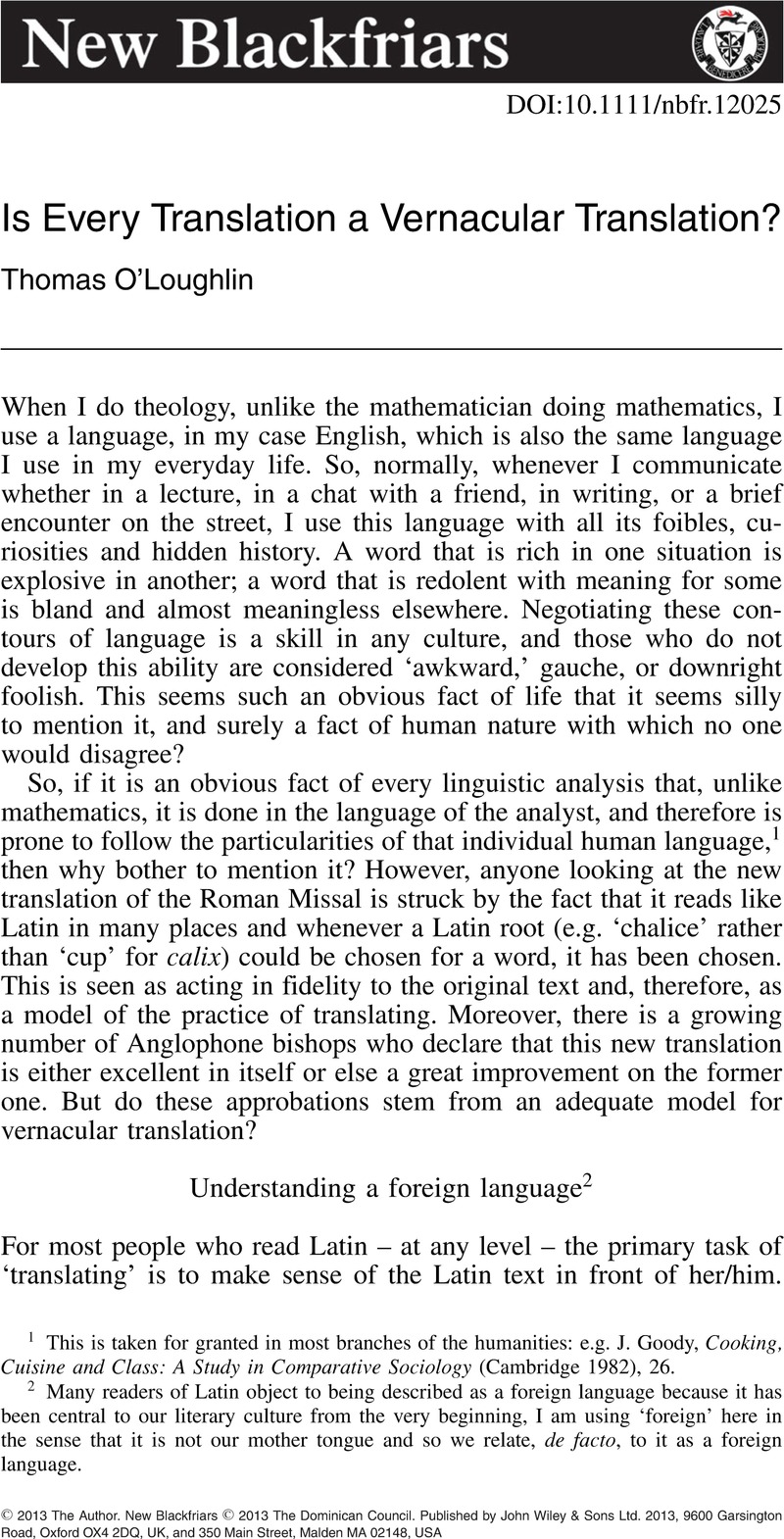No CrossRef data available.
Article contents
Is Every Translation a Vernacular Translation?
Published online by Cambridge University Press: 01 January 2024
Abstract

- Type
- Original Article
- Information
- Copyright
- Copyright © 2013 The Author. New Blackfriars © 2013 The Dominican Council.
References
1 This is taken for granted in most branches of the humanities: e.g. Goody, J., Cooking, Cuisine and Class: A Study in Comparative Sociology (Cambridge 1982), 26CrossRefGoogle Scholar.
2 Many readers of Latin object to being described as a foreign language because it has been central to our literary culture from the very beginning, I am using ‘foreign’ here in the sense that it is not our mother tongue and so we relate, de facto, to it as a foreign language.
3 For instance: Diamond, W., Dictionary of Liturgical Latin (Milwaukee, WI 1961)Google Scholar.
4 One can see this rationale at work in the way the grammatical textbooks for students are produced, see (the rather excellent) work of Swetnam, J., An Introduction to the Study of New Testament Greek (2 vols, Rome 1992)Google Scholar.
5 See the study of his translation method in O'Loughlin, T., ‘The Controversy over Methuselah's Death: Proto-chronology and the Origins of the Western Concept of Inerrancy', Recherches de Théologie Ancienne et Médiévale 62(1995)182–225CrossRefGoogle Scholar.
6 The problems of a lectionary that actually conveys its message adequately (leaving aside aesthetic concerns such as those who are devotees of Jacobean English) in contrast with a good text for use in class brings out the different demands of translators: one is for ordinary communication which must be understood while being heard, the other is for use at a desk with time and the intention of teasing out meaning. See O'Loughlin, T., ‘“Would you read?”: The Task of the Lector,' Anaphora 1.2(2007)19–36Google Scholar.
7 For instance: Kohlenberger, J.R. III ed., The NIV Interlinear Hebrew-English Old Testament (Grand Rapids, MI 1979)Google Scholar; or Marshall, A ed., The Interlinear Greek-English New Testament (London 1958)Google Scholar.
8 For instance: Kubo, S., A Reader's Greek-English Lexicon to the New Testament (Edinburgh 1975)Google Scholar.
9 See O'Loughlin, T., ‘Translating Panis in a Eucharistic Context: A Problem of Language and Theology,’ Worship 78(2004)226–35Google Scholar.
10 See O'Loughlin, T., The Didache: A Window on the Earliest Christians (London 2010), 85–104Google Scholar.
11 See O'Loughlin, T., ‘The Praxis and Explanations of Eucharistic Fraction in the Ninth Century: the Insular Evidence,’ Archiv für Liturgiewissenschaft 45(2003)1–20Google Scholar.
12 The Jerusalem Bible (London 1966)Google Scholar used ‘loaf’ at 1 Cor 10:17 recognising that this was necessary for the body symbolism used here by Paul and also found in the Didache, but elsewhere (e.g. 10:16 and 11:24 and 27) used ‘bread’.
13 See O'Loughlin, T., ‘Eucharistic Celebrations: the Chasm between Idea and Reality,’ New Blackfriars 91(2010)423–38CrossRefGoogle Scholar.
14 Nativity of our Lord, Vigil Mass, Opening Prayer.
15 Second Week of Advent, Tuesday, Opening Prayer.




